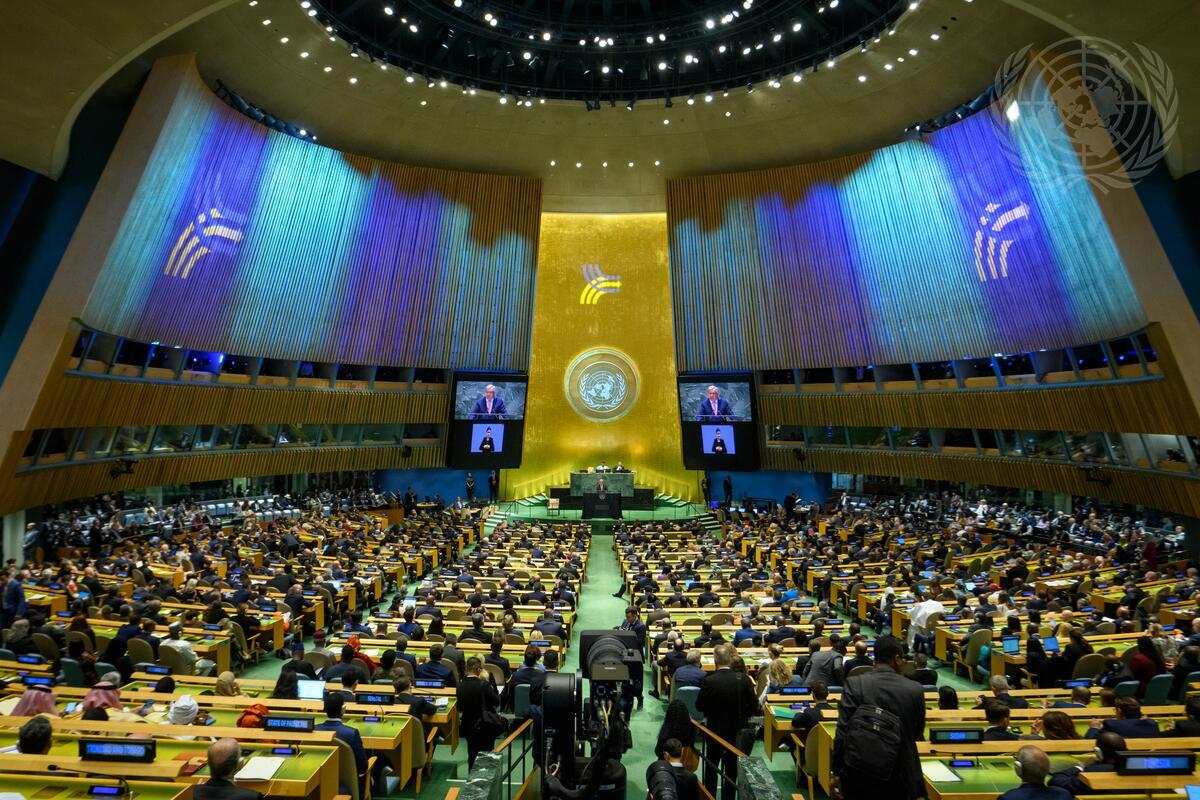United Nations
Global Digital Compact adopted by UN Member States

A wide view of the General Assembly Hall as Secretary-General António Guterres (at podium and on screens) addresses the opening of the Summit of the Future.
© UN Photo/Loey FelipeOn Sunday, 22 September 2024, the Global Digital Compact was adopted as an annex to the Pact of the Future.
During the period preceding the Summit of the Future, more than 10 states broke the silence procedure of the GDC and there was a last minute attempt to derail the adoption of the Pact of the Future, to which the GDC is annexed.
During the opening of the Summit, the Russian Federation submitted an amendment (A/79/L.3) to the text of the Pact of the Future (A/79/L.2), sponsored by Belarus, Democratic People’s Republic of Korea, Iran, Nicaragua, and Syrian Arab Republic. They were seeking to include a paragraph stressing that ‘the United Nations and its system shall not intervene in matters which are essentially within the domestic jurisdiction of any State as provided in Article 2 (7) of the Charter of the United Nations’, as quoted in the amendment L.3. The representative of the Russian Federation went on to criticize the UN for not adhering to its principles and not discussing an issue brought to the table by the Russian Federation. Some states supported the amendment, as for instance Venezuela, who urged states to vote in favor of the amendment introduced by the Russian Federation.
The Republic of the Congo reacted by introducing a motion of no action in regards to the amendment. Most states welcomed this motion and it was adopted by vote:
-
143 in favor
-
7 against (Belarus, Democratic People’s Republic of Korea, Iran, Nicaragua, Russian Federation, Sudan, Syria)
-
15 abstentions Algeria, Bolivia, China, Cuba, Iraq, Kazakhstan, Kiribati, Lao, Malaysia, Maldives, Oman, Pakistan, Saudi Arabia, Sri Lanka, Thailand)
The Pact of the Future, and thereby the GDC, were then adopted by consensus, without a vote.
While China abstained and did not vote against the motion of no action introduced by the Republic of the Congo, Chinese Foreign Ministry spokeperson Lin Jian commented on the adoption of the GDC. ‘China welcomes the adoption of the Global Digital Compact at the UN. (…) China is committed to promoting global digital governance with the UN as the main channel.’, stated Jin Lian in a press conference on September 23. He added that the principles of the GDC align closely with the vision of China’s Global Development Initiative and Global Civilization Initiative. In geopolitical terms, their different approaches to the GDC highlight a substantial difference between the Russian Federation and China, who often align in their geopolitical ambitions in regards to the West. Both, Russia and China, have historically been trying to loosen the human rights criteria of UN resolutions, having succeeded in many cases.
The GDC has become vaguer in its human rights implications and formulations from the zero draft to the fourth revision adopted at the Summit. While civil society around the world reiterates certain shortcomings of the Compact, its adoption has received considerably positive reactions from stakeholders around the world.
The biggest challenge before the adoption of the Compact was to find consensus. States clashed over sensitive issues like cross-border data flows and military use of technology. While the majority of states were in favor of adopting the Compact, it is important to note that not all states are satisfied with the final draft.
The next step is the implementation of the GDC. This entails the creation of new mechanisms, alliances, and collaborations and the strengthening of existing ones. Through the Compact, two new mechanisms are created, an Independent International Scientific Panel on AI and a Global Dialogue on AI Governance. The OECD and the UN have also announced a collaboration, which aims to support countries in adapting and implementing policies to the rapid evolution of AI technology. The 50-in-5 campaign set up in 2023 will help 50 countries design, launch and scale Digital Public Infrastructure (DPI) by sharing good practices and knowledge.
The goal is to streamline global digital governance while respecting the capacities and priorities of the countries. It remains to be seen how effective the GDC will be. Fortunately, the objectives of the Compact are quantifiable and measurable and therefore the potential impact will be clearly visible. The first review of the GDC is scheduled for 2027.
Unpacking the Global Digital Compact

The United Nations Member States vision will be on display at the Summit of the Future 2024 in New York from September 21 to 25. The main outcome of the Summit will be the adoption of the ‘Pact of the Future’. The Pact also contains another document that is supposed to be adopted at the Summit: The Global Digital Compact. This article will unpack the raison d’être of the Compact and analyse how human rights are implied, before critically assessing the GDC from a human rights perspective.
